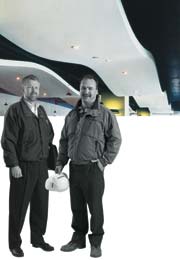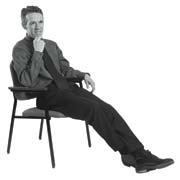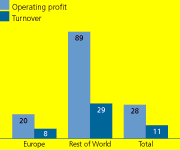
| Introduction | |
| Financial highlights | |
| Routes to market | |
| Chairman’s statement | |
| Chief executive’s review | |
| Operating review | |
| Finance director’s review | |
| Directors | |
For a printer friendly version of this Annual Report website plus PDFs of the rest of the document please visit the PDF download section . |
|
| Building materials | 2000 | 1999 | % increase |
| Turnover (£m) | 221.8 | 220.2 | 1 |
| Operating profit (£m) | 16.5 | 10.8 | 53 |
| Margin (%) | 7.4 | 4.9 | |
The region saw a significant improvement in results, with profits (before restructuring costs) doubling from last year’s low. However, trading conditions were challenging in this complex region encompassing the Balkans, former Soviet states and now Turkey.
In Germany construction activity remained weak with competition fierce. Plasterboard volumes were flat although year-on-year average selling prices for plasterboard did recover by 6% after a 12% fall last year, and were 13% higher in March 2000 than twelve months earlier; profits were also helped by the manufacture of 10 million square metres of plasterboard for export to North America. The gypsum fibreboard plant at Bodenwerder completed commissioning early in the year, bringing an extended range of locally produced building solutions to the market. New high specification plasterboards and joint fillers have been added to the Rigips range and further cost initiatives helped double the German profit. The outlook remains challenging with little improvement in the overall market, which continues to be held back by activity weakness in the east. The acquisition of the Heidelberger Dammsysteme expanded polystyrene business will further extend our product offering and deliver cost and sales synergies.
Poland is now our second most important market in the region, experiencing double-digit construction growth, and plasterboard per capita consumption exceeding those of several EU countries. The market place remains highly competitive and prices fell by more than 10% to the lowest levels in Europe. However, the successful commissioning of the Stawiany plant in the spring of 1999 has given us a highly efficient production platform and moved the business into profit. During the year further progress was made in promoting plasterboard accessories, building plasters and ceiling tiles and, despite the selling price weakness, total turnover increased by a third.
In the Czech Republic the economy showed signs of recovery, with plasterboard sales more than 10% above last year but prices down by 7%. Our new Melnik plasterboard plant, situated just north of Prague and using co-located power station desulphogypsum, has secured a low-cost base to supply future growth both locally and to neighbouring Slovakia and Romania. As in Poland, the new plant was commissioned swiftly and moved the business into profit.
By contrast, in Austria we experienced a flat construction market and transferred eastern European sales to our local plants. However, profitability was maintained on stable prices, modest domestic plasterboard volume growth, exports to North America, and manufacturing efficiencies.
After almost a decade of building recession, the market in Switzerland has begun to stabilise, with the Rigips name gaining further acceptance in the market place. Profits advanced by over 50% due to cost reductions, range improvements and integration in the region.
Elsewhere, strong growth was achieved in Hungary and also in the smaller markets of Greece and Romania which are serviced in part from local manufacturing plants.


Key members of the Westroc team responsible for the design, specification and delivery of flexible gypsum board installed as curved ceilings in the Air Canada Centre, a multi-purpose sports and office complex in Toronto: Ron Walker, product manager (seated), Glenn Liscumb, sales representative (top left), and Barry Blue, shipping representative.

BPB building materials growth in turnover and operating profit % increase on previous year
| << previous page | [ 1 | 2 | 3 | 4 ] | continued >> |
[ back to top ]